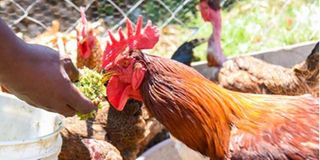
Mary Odhiambo at her poultry farm in Atilili Village, Siaya County. After losing nearly 200 birds to poor quality feed, she started feeding them azolla.
In the middle of this year, Mary Odhiambo, a resident of Bondo, Siaya County, suffered heavy losses after feeding her improved kienyeji chickens with substandard commercial feed.
Ms Odhiambo's predicament began when a friend tipped her off about cheap chicken feed.
Unlike what she was getting from an agrovet at Sh3,500 per 70kg bag, the new feed cost Sh1,000 less.
Within days, her birds were falling sick and dying. More than half of the 400 chickens died within two days, a loss of at least Sh50,000.
“The deaths only added to the losses I had incurred a month prior to buying the feeds due a power outage,” the farmer says.
When the Seeds of Gold arrived at Ms Odhiambo’s home in Atilili Village, she was working on the pond where she grows azolla.
The aquatic plant supplements commercial feeds.
“I was introduced to azolla during a training on poultry farming in Siaya,” she says, adding that apart from being easy to grow and manage, azolla matures in just two weeks.
All she needs is a four-metre square pond and a dam liner. The pond should be in a place where the azolla plants are not exposed to direct sunlight.
“That is why my pond is under this huge tree. The pond is 60 centimetres deep,” she says.
After digging, she laid a liner to hold the water in. Before planting the azolla, she adds cow dung to the pond. It is stirred with water to make an even mixture and left for three days before the azolla seeds are added.

Chicken feed on azolla in Machakos County. Farmers in Siaya have embraced the feed.
After harvesting, the feed is fed directly to mature chickens. The chicks eat sun-dried azolla.
“Managing my birds is far much cheaper compared to the time I solely depended on commercial feeds,” Ms Odhiambo says.
Most of her current stock has been sold.
“I have sold 40 mature chickens in the last two weeks and hope to dispose of the remaining ones and buy day-old chicks,” she says.
Ms Odhiambo is one of hundreds of farmers in Siaya enrolled in the Resilient Agriculture for the Young (RAY) programme, supported by the NGO Practical Action in partnership with the MasterCard Foundation.
Benta Akech, one of the implementers of RAY and a promoter of regenerative agriculture, says the programme focuses on training farmers in azolla vermiculture, black soldier fly and compost production.
She says azolla is a source of protein and can be used as supplementary feed for poultry, pigs and fish.
“If you plant azolla today, expect to harvest in 14 days. With the right manure, the plant will be ready for consumption by poultry in seven days,” she says.
Akech adds that a farmer should not harvest everything once it has matured. A third of the azolla is left to be used as seed for the next crop.
According to Akech, a pond can be up to six metres deep. She warns against using chicken manure in the pond because of its high ammonia content.
“Do not use fresh cow dung because it has urine, which is toxic to azolla,” she adds.
“Decomposed manure gives the azolla plant the required nutrients and quickens growth.”
She says that when grown in direct sunlight, azolla leaves turn yellow.
Harvesting is done using a sieve, and a pond can be harvested up to six times.
After the sixth harvest, the pond should be emptied and the water and manure mixture spread on vegetable farms.
Azolla feed should not be fed to broilers as the proteins are converted to fat. The feed is ideal for improved kienyeji and local chicken breeds.
Once the birds start laying eggs, the azolla feed should be withdrawn.
Melvin Otieno, who is in charge of RAY in Siaya County, says the programme aims to support young agripreneurs in the poultry, African leafy vegetables, groundnut and soya value chains.
"Azolla helps farmers minimise costs. Households also use locally available materials to feed their chickens," says Otieno.










